Social Innovation with Art-Sci-Tech
School of Arts is a part of a small but distinctly international University of Nova Gorica, which provides a fruitful environment for interdisciplinary research. In addition to participating in humanities projects, at this institution art finds ways to cooperate with natural sciences, environmental sciences, karstology, physics and astrophysics. Students get familiar with the interdisciplinary field of art-science-technology (AST) either through videofilm formats (mentor Assoc. Prof. Jasna Hribernik) or through the one of carrier modules, such as New Media (module leader Assoc. Prof. Peter Purg, PhD) and Contemporary Art Practices (module leader Prof. Rene Rusjan). For several years the School of Arts’ main AST guest mentor has been Robertina Šebjanič, who mentors students from different fields of interest (film, animation, photography, new media) who share a passion for scientific and technological approaches within art. Last year the UNG School of Arts succeeded in accrediting a novel Master Module in Art, Science and Technology (MAST), exploring how the imagination of artists and their tools for creativity can bring about true innovations that could tackle the most complex challenges of the future, both for society at large, and industries. Next to accrediting an international master module, participants from a variety of disciplines have jointly explored and identified the vectors of possible policy impacts and priorities for the future of Europe as well as created alliances for forward-thinking future actions. MAST was created by a consortium of partners within an EU supported project, coordinated by the UNG School of Arts, including the Institute of Spatial Design at Graz University of Technology, the Madeira Interactive Arts Institute, and the NGOs Culture Action Europe from Brussels, the Croatian Cultural Alliance from Rijeka, and the Kersnikova Institute from Ljubljana, (2018 – 2020) The MAST spirit continues to live in the konS– Platform for Contemporary Investigative Arts where the Innovation Catalyst profile is being pursued and developed in practice through hundreds of workshops, dozens of cutting-edge artistic productions and a robust transfer-to-industry mechanism. The most recent project upon the legacy of the MAST, is Loose Cells. Since February 2021, experts, professors and students have been creating a multi-layered art-science object addressing issues, such as sea level rise, wood properties/buoyancy, sustainability of the building sector and human-nature-technology relationships. It was designed by a consortium of four partners and the research institute InnoRenewCoE as the main driver of the project. Other partners are: the University of Primorska and the Association for Culture and Education PiNA (with the support of the RUK network of research centers).

Social Innovation with Art-Sci-Tech, Peter Purg (SI), New media Carrier module leader Rene Rusjan (SI), Contemporary art practices Carrier module leader Robertina Šebjanič (SI), Art & Science guest mentor, Credit: Peter Purg

Social Innovation with Art-Sci-Tech, Peter Purg (SI), New media Carrier module leader Rene Rusjan (SI), Contemporary art practices Carrier module leader Robertina Šebjanič (SI), Art & Science guest mentor, Credit: Peter Purg

Social Innovation with Art-Sci-Tech, Peter Purg (SI), New media Carrier module leader Rene Rusjan (SI), Contemporary art practices Carrier module leader Robertina Šebjanič (SI), Art & Science guest mentor, Credit: Archive UNG AU

Palingenesis of Fluvial dialects in Anthropocene Epoch – Miha Godec, Credits: Miha Godec

Palingenesis of Fluvial dialects in Anthropocene Epoch, Greetings from the Future IV, University of Nova Gorica School of Arts, Nova Gorica (SI), Credits: Miha Godec
ZurückWeiter
Peter Purg: is a renowned external expert on academic quality and is currently president of the Slovenian Quality Assurance Agency Council, appointed by the Slovenian Rectors Conference for the 2016–2022 mandate. Currently, he is also serving as member of the Higher Education Council of the Republic of Slovenia. He was member of the Expert Committee for Intermedia Art at the Slovenian Ministry of Culture. He acted as independent consultant or advisor in several artistic, cultural, research and development projects for the public (schools, universities, ministries) as well as across Creative and Cultural Industries. He recently led the interdisciplinary MAST – Module in Art, Science and Technology project, and he currently leads School of Arts’ new media project teams, such as konS– Platform for Contemporary Investigative Arts.
Rene Rusjan: explores art through the prism of its role in our lives, and as a tool for establishing communication between ourselves, between different levels of society, relations between different disciplines, and understanding the other. She is an independent artist from 1988 to 2009, she cofounded the Cultural Association Galerija GT (1988), and the Famul Stuart School of Applied Arts (1994). She is also a co-creator of its successor, the School of Arts of the University of Nova Gorica and its BA and MA programs, where she works as the program director and professor of contemporary art practices since 2009.
Robertina Šebjanič: is an internationally awarded artist and educator, whose work revolves around the biological, chemical, political, and cultural realities of aquatic environments and explores humankind’s impact on other species and on the rights of non-human entities, while calling for emphatic strategies towards other species to be adopted. Robertina was awarded with Honorary Mention @Prix Ars Electronica 2016; she was nominated for STARTS2016 and STARTS2020. She was SHAPE artist in 2017; in 2018 she was a resident artist at Ars Electronica (EMARE / EMAP). Her artwork Aurelia 1+Hz / proto viva generator is since 2019 part of the BEEP Electronic Art Collection (Spain).







